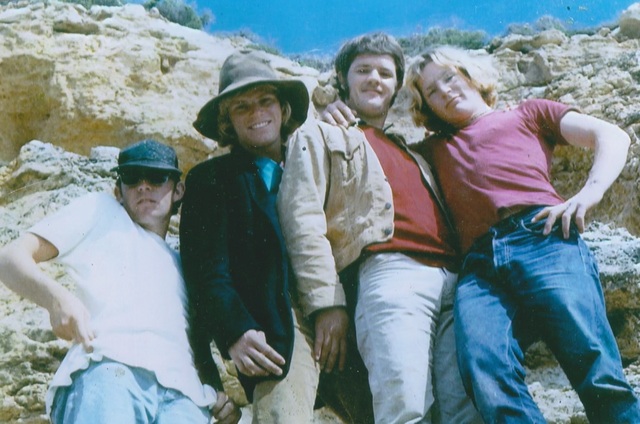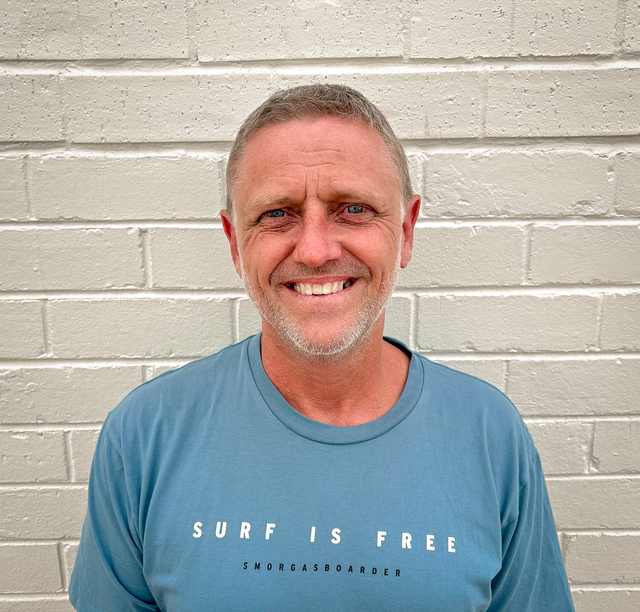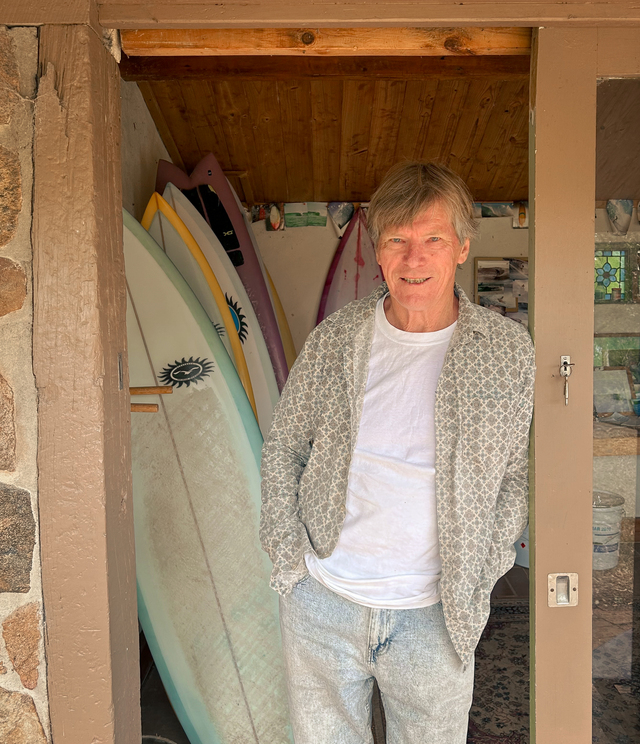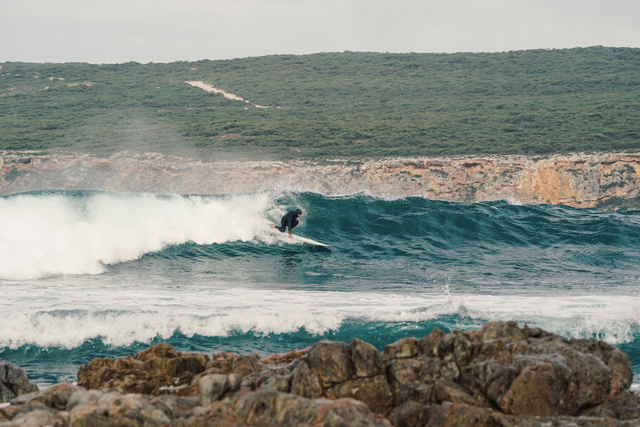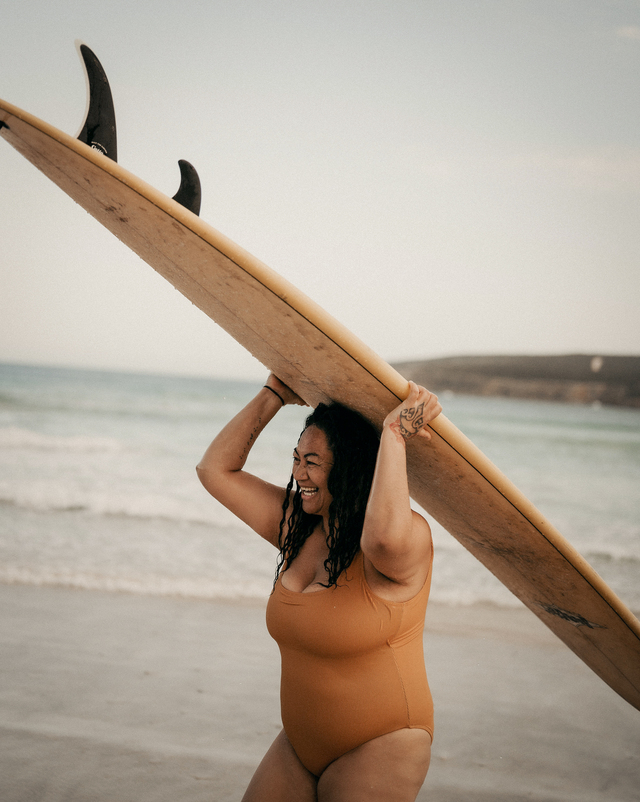
There may have been changes made over the years, but the sense of community and a desire to catch waves remains at Fishery Bay.
Eyre Peninsula has an intricate, intimate and sometimes even secret history of surf culture that is continuing to evolve along its coastline to this day.
Groups like Fishery Bay Surf Riders and Lincoln Board Riders have come and gone – and come back again – as have many of its members, but what has always remained is the “love and the stoke” for surfing, according to Ngahuia Trewartha.
Ngahuia is a pillar of Port Lincoln’s surfing community and the heart behind the resurgence of the Fishery Bay Surf Rider community over the past few years.
Ngahuia is an ocean-lover, a wife, a grandmother and a civil celebrant who is fiercely passionate about family and community, while still giving a sense of ease and space for evolving ideas and new connections.
“I think because I’m turning 50 this year I’m really giving my attention to legacy – I want to have something solid in place so that everyone else that follows behind us has a beautiful clean ocean to feel connected,” she said.
“Fishery Bay is that place for us, in our family we have four generations of surfers. Our granddaughter, Mana Love, is one. We have her out by the sea often, with her surfing parents. My husband Matt began surfing here and his father also surfed here.
“When we go out, I see women walking on country to be in nature. I’ve married and farewelled friends there; it’s a really sacred space.”
Over the decades, there is no denying that surfing culture has changed, but the desire for the ultimate lifestyle it can bring and the possibilities of a perfect wave has remained the same.
Matt Trewartha is a Fishery Bay Surf Rider and a wave chaser who first learnt to surf at Fishery Bay in the 1980s.
“My mum was the one to take me out to Fishery Bay the first time, she just said do I want to try surfing and once I’d had a go that was it, we’d get dropped out there with our friends,” he said.
“There were no car parks or signs, just the tracks, but the waves haven’t changed. There’s so many options for good surfing at Fisheries, different winds on both sides of the bay at The Points and the beach is easy, you’ve nearly always got an option to get a wave there and it’s so close to town.
“Dad used to go out with his mates, go surfing and go spear fishing at The Points; it was a recreational spot for him.”
Matt said surfing communities like Fishery Bay Surf Riders were good for fostering safe surfing environments.
“You can get surf reports, have people looking out for you, it’s a pretty solo pursuit at times but Surf Riders always gives you someone to talk to or to line up someone to surf with,” he said.
“Fishery Bay is an important space for local surfers.”
Ngahuia said as the years have passed, after three decades of her time connecting with the area and people of Fishery Bay, some relationships had come full circle.
“Now I’m returning dear friends back to that beach at Fishery Bay, ashes to the seas and putting them back to the water,” she said.
“We have a beautiful community, mums and bubs, beachcombers and surfers.
“Surfing is just fun and the culture is one of connection, something where you can share rites of passage like your first paddle, your first camp, your first wetsuit and your first visit out to the point. From there you can’t help but start to explore who came before us, what kind of boards did they ride and for what reason?”
A man that can answer some of these burning questions is Geoff White, a former Lincoln Board Rider who has owned and operated his own business, Albatross Surfboards, from Port Lincoln since 1973.
He has very fond memories of surfing at Fishery Bay and can recall some of those earlier surfing years, having first started surfing at about 15.
“Some of the older guys had built a wall around the cave at Right Point at Fisheries, it had tin across it and a seat outside and everything. Everyone used to go to that cave, we used to go and sleep in it at night,” he said.
“Trevor White took a lot of footage of the place back in the 60s, there used to be a billboard out there, I think it said ‘The Fishery Bay Surf Riders welcome you to fabulous Fisheries’, just past Theakstone’s farm as you’re heading out – back then it was hard to get out there, it was a really bumpy dirt road the whole way so you had to have a car, that’s why most of us didn’t start surfing until 15 to 16 or they just hung around guys with cars to get out there.”
“I used to go up to Cactus for a bit too, I lived there in the early 70s working as a diver on the jetty, back in those days nobody lived at Cactus, there was never anyone else there unless it was Easter or Christmas.”
In 1973, filmmaker Paul Witzig travelled through Cactus Beach and filmed a surf movie, ‘Rolling Home’.
“Cactus wasn’t very well looked after for a bit, after the time of the movie a huge amount of people went there in the mid-70s, even just travelling through to Western Australia, Cactus got really crowded and there was a lot of rubbish, and burnt shrubs,” Geoff said.
“Witzig had bought the land earlier but didn’t start the camp area until ‘76, he was charging people 50 cents a night to stay there, but he built toilets and put rubbish bins out and started to revegetate the land – it looks great now, the hippie movement helped with that too people got a bit more environmentally conscious I suppose.”
Flash forward to the 1990s, Geoff was back living in Port Lincoln and found himself as a member of the Lincoln Board Riders.
“It was sort of like a social club, there were small contests for the kids and get togethers on Friday nights, I reckon Barry ‘Tiki’ Ellis was one of the main ones to get that going.”
Geoff said groups like Lincoln Board Riders were beneficial for surfing families and their children.
Another local fisher, father, grandfather and Fishery Bay Surf Rider with a rich knowledge of its history and the boards is Mick White.
Mick is the nephew of South Australian surfing great Kenneth ‘Kiwi’ White and of his surfing mentor, founding member of the Fishery Bay Surf Riders, his adopted uncle Trevor White.
“You gotta remember back then these guys had no idea they were writing history,” Mick explained.
“To these guys it was just about surfing, but it’s a part of what we now look at today as the blueprint for surfing in Australia.”
Fishery Bay Surf Riders, he said, had a lot to do with that.
“Fishery Bay Surf Riders were right in the thick of it at the start of this cultural movement in the 50s and 60s, pre-wetsuits, pre-foam boards, we’re talking hollow timber boards that turned into balsa and so on,” Mick said.
“Uncle Kiwi and his mates would come back from a trip overseas and suddenly there’s foam boards or fibreglass on them.
“In 1962, uncle Trevor and the Fishery Bay boys formed the Fishery Bay Surf Riders, they made a patch and my uncle even had a car called The Chaser – and that’s what they did, they chased the surf.”
Mick described some of the cultural changes surfing has had since his uncle’s time in the 1960s and 1970s.
“Back then, females really weren’t a part of this, it’s only in the past couple of decades we’ve seen a real strong push from women coming into surfing here in Australia, especially with longboarding; prior to that it was mainly boys living off the land and the ocean and surfing all day. It’s changed so much for the better,” he said.
“I have days out at Fisheries where I’m the only guy with about 10 girls out surfing.
“The entire culture has changed for men and women and it doesn’t matter what board you’re on, you can just go out, surf and have a good day.”
The inevitable influence of the internet has made its way to the Surf Rider community, but Mick believed they had to accept the changes.
“Because of social media we’ve had to accept that everyone knows where we are, and because of this there’s no such thing as a secret spot anymore, but that’s time,” he said.
“As an example, I remember when they put the boardwalk in at Fishery Bay, I didn’t like it at first when I found out, but once it was in I started using it to get on and off the beach to make life easier for me. What I also found was I had a huge amount of interaction with people where it was their first time coming to the bay, and it was a great way to educate people about the place.
“Now every time I go there I could spend an extra hour just talking to tourists that appreciate that the area even exists. One time I went surfing with a Japanese family and we surfed with a couple of hundred stingrays following us, that was pretty amazing.”
Ngahuia, Matt, Mick and the Fishery Bay Surf Rider community are all hoping Fishery Bay will be added to the National Surfing Reserve list.
Mick said Fishery Bay has had its rough times over the past 50 years.
“But that’s why our community, its relationships like that with Lower Eyre Coastcare and the potential to add it to the National Surfing Reserve list is going to be really important for its future,” he said.
“The place has changed, the people have changed, but we can help keep the place as it is. We can fight to protect it, its history and keep it as somewhere for everyone to continue to experience.
“I’m a Fishery Bay person, I will be there at the end, my family knows that’s where my ashes will go, same as some of the other family, because that’s what the place means to us. I wouldn’t be anywhere else, not in a million years.”
The Fishery Bay Surf Rider community is preparing for its first ever Surf Festival, to be held in September 2024.
There will be a number of community events held over 10 days in Port Lincoln, as well as a surfing expression session at Fishery Bay.
For more information, visit the instagram page, fisherybaysurfriders_community

